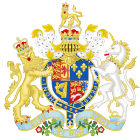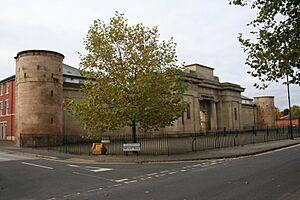Derby Gaol facts for kids
Derby Gaol is the name for five old prisons that used to be in Derby, England. Today, when people talk about Derby Gaol, they usually mean two places that are now visitor attractions. One is the Friar Gate Prison, which was used from 1756 to 1846. You can still visit its old cells today. The other is the Vernon Street Prison, used from 1843 to 1929. Its front part is still there, but the building is now used for offices.
Contents
History of Derby's Prisons
Long ago, in 1652, there was a prison called the Cornmarket Gaol in Derby. This building no longer exists. A famous person named George Fox was held there. He was accused of saying things against religious beliefs. George Fox later started a Christian group called the Religious Society of Friends, also known as the Quakers. Some people say that a judge in Derby first called them "Quakers" because he told them to 'quake for fear of the Lord'. However, this name had been used before for other groups, so the story might not be completely true.
Friar Gate Prison: An Old Jail You Can Visit
52°55′29″N 1°29′14″W / 52.92472°N 1.48722°W
Quick facts for kids Derby Gaol Act 1756 |
|
|---|---|
| Act of Parliament | |

|
|
| Long title | An Act for re-building the Common Gaol for the County of Derby, upon a Place called Nun's Green, in the Liberty of the Town of Derby; and for appointing a proper Place for the safe Custody of Prisoners till such new Gaol shall be compleated; and to empower the Justices of the Peace for the said County to pay the Rent reserved to the Corporation for the said Ground, out of the County Rates. |
| Citation | 29 Geo. 2. c. 48 |
| Territorial extent | Great Britain |
| Dates | |
| Royal assent | 9 March 1756 |
| Commencement | 13 November 1755 |
| Repealed | 30 July 1948 |
| Other legislation | |
| Repealed by | Statute Law Revision Act 1948 |
|
Status: Repealed
|
|
| Text of statute as originally enacted | |
The building of the Friar Gate Prison was approved by a law called the Derby Gaol Act in 1756. This prison was the site of many serious punishments. Today, the small visitor attraction shows copies of old newspaper stories about these events. There is also a model of the gallows that once stood in front of the building, located in the prison's small garden.
Vernon Street Prison: The New County Gaol
52°55′24″N 1°29′29″W / 52.92333°N 1.49139°W The Vernon Street Prison was known as the county prison from 1843 to 1919. The last public execution in Derby happened here in 1862. It was for Richard Thorley, who was found guilty of murder. The very last person to be executed at this prison was William Slack on July 16, 1907. He was found guilty of murder.
From 1919 to 1929, the building was used as a military prison. After that, it was closed down. The prison was later taken apart, and the area became the Derby Greyhound Stadium. Today, the site has offices, but you can still see the historical front of the building.
Famous People Held at Derby Gaol
- Jeremiah Brandreth – held for a serious crime against the government.
- Humphrey Berisford – held for not following the official church.
Images for kids


